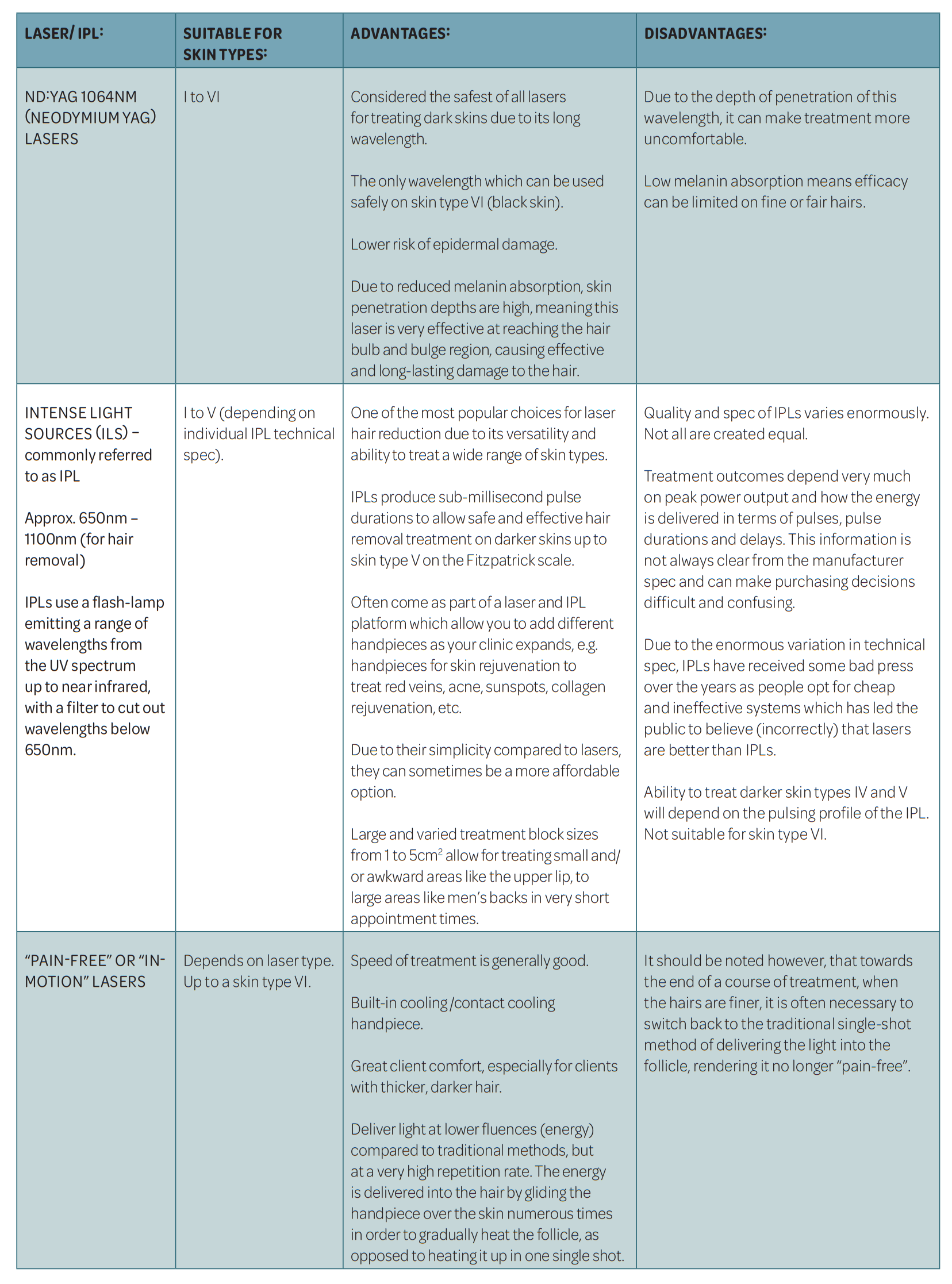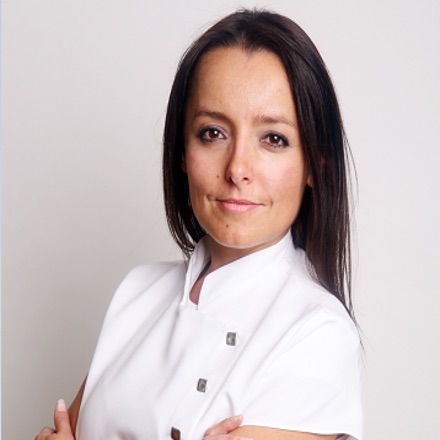Which laser device to invest in for your clinic

Deciding to offer laser hair removal for your clinic is easy. Deciphering which laser or IPL is the right one for your business can be daunting and confusing, not to mention incredibly time consuming. Doing your homework beforehand however, ensuring you choose the right system for you, can not only save you time and money, but can make or break your clinic and its reputation.
Back in 2004/2005 when I first opened my laser and skin clinic, there weren’t as many laser and intense light source (ILS), commonly known as IPL, suppliers in the industry as there are now. Having a choice of where to buy can only be a good thing of course, but it can make your purchasing decision even more confusing, especially when each manufacturer professes that their laser or IPL is the best, when in reality they are not all created equal. My advice? Know your lasers and wavelengths before contacting any manufacturers, as this will not only empower you as a consumer, but will provide you with clear direction as to which laser and/ or IPL is right for you.
INTO THE LIGHT
So, let’s talk wavelengths. In simple terms a wavelength is the distance between two points on a wave, which are separated by a complete cycle and for visible light is measured in nanometers (nm). Different wavelengths produce difference colours of light. Each colour of light will be absorbed by different targets of colour. For instance, a red tattoo would need to be treated with a laser emitting green light, and vice versa. The light is absorbed by the coloured target, (e.g. a red vein or a green tattoo) and either heats it, or shatters it into tiny particles.
In the case of hair removal, the chromophore (target of colour) is the pigment in the hair. Pigment can be absorbed by a wide range of wavelengths in the visible and near infrared spectrum, which is why when it comes to choice of device, there is an array of both lasers and IPLs.
The technical term for what is happening when we laser or IPL a hair is “selective photothermolysis”. We are selectively heating a hair (the target) while protecting the surrounding tissue in the skin. Without selective photothermolysis, we would be heating up both hair and skin, risking burns and blistering.
While all wavelengths used for laser/ IPL hair removal are suitable for the removal of the hair itself, they are not all necessarily appropriate for all skin types I – VI on the Fitzpatrick Scale; skin type I being white skin which cannot tan, and skin type VI being black skin. Lighter colour skin can be treated with any of the wavelengths, while darker skin requires wavelengths that are not as well absorbed by melanin, which means they go deeper into the skin, bypassing most of the skin’s epidermal melanin.
Lasers and IPLs emitting light between approximately 650nm and 1100nm can all be used to permanently reduce hair. Each has its advantages and limitations depending on intended use as indicated in the tables below.


EDUCATION
One of the most important considerations when choosing a laser or IPL is the training that comes with it. Back when I was looking at purchasing my first laser, the manufacturer training varied enormously. One particular company provided a mere three hours’ training, which unbelievably also included time for PAT-testing the machine. This, in my opinion, is nothing short of irresponsible. Lasers and IPLs are the most incredible pieces of engineering genius, which have revolutionised aesthetics, but they also come with the potential for serious side effects, especially when insufficient training is provided. As such, any laser or IPL manufacturer not providing an absolute minimum of one to two full days of training are not, in my opinion, worth considering.
CLINICAL SUPPORT
In addition to initial training, a good equipment supplier will provide excellent on-going clinical support and training, not only for tips on getting the best possible treatment outcomes, but for if and when things go wrong. Your equipment should come with medical protocols, written by an expert healthcare practitioner (EHCP), as these will form the basis upon which your insurance is provided. In addition they should be able to provide you with a laser protection advisor (LPA), which is also a requirement if you are Care Quality Commission-registered (CQC). Lastly, while not essential, choose a laser/ IPL supplier with an active customer forum or group where you can tap into a wealth of clinical knowledge and support, whose members are only too keen to help and impart their knowledge to you, the latest “family member” to enter the fold.
MARKETING
Any equipment supplier worth their salt will naturally provide you with outstanding marketing support. Choose only suppliers who make your success their absolute mission. Expect to be able to access a customer portal with an abundance of high-quality, downloadable marketing materials which are free of charge. Also look for suppliers that hold regular clinical update seminars, some of which should count towards your continual professional development (CPD).
Still confused? Look at your demographics and choose a system which allows you to treat as many skin types as possible. Ideally, and if you wish to expand into other treatment areas like skin rejuvenation, choose a laser or IPL which comes as part of a system platform where you can add handpieces as and when you wish. I have a total of 11 different laser and IPL handpieces on two platforms in my toolbox, three of which are for hair removal.
I started out with a long-pulsed Nd:YAG 1064nm and a superb IPL 650nm which produced sub-millisecond pulse durations. Three years later I introduced an additional but far more aggressive IPL to tackle finer, lighter hairs. At the time, I was considering an Alexandrite but when I discovered that one of the laser nurses at a large NHS laser centre preferred it to the Alexandrite for results and speed of treatment, it was a no-brainer. After all, I had the platform ready to receive this new IPL, the clinical white papers and the endorsement of an experienced laser nurse to back it up.
With a total of three laser and IPL handpieces, it meant I could treat any skin type walking through my clinic door, despite the fact that where I am based – Bournemouth – is sadly not that ethnically diverse. For me however, it was hugely important that I didn’t have to turn away any clients based on the colour of their skin. It also meant that by having a long pulsed Nd:YAG, I was also able to treat leg veins. These small considerations and tidbits of knowledge, in terms of equipment versatility and application prior to your equipment purchase, can have a big positive impact on your business.
Lastly and most importantly, take great care and time in choosing your equipment provider. Making good choices in terms of your laser and IPL supplier is absolutely key in terms of the quality of the machine, your treatment outcomes, the reputation of your clinic and ultimately, the longevity of your business. I do not allow any suppliers who do not share my ethics into what I call my “circle of trust”, and equally, it should be an absolute privilege for suppliers to earn a place in your portfolio of clinic equipment. When I invite a supplier into my circle, I don’t just buy a piece of equipment, I expect to buy into a family whose members have my back and are as keen as I am to get incredible results for my clients. With high standards and thorough research, you will find the right supplier and the perfect system for your clinic.
Kerry Belba is owner of Laser Skin Solutions in Bournemouth. She is a qualified laser technician, laser trainer and key opinion leader. She has obtained the nationally-recognised BTEC, CIBTAC and VTCT Laser & Light Awards in addition to the Lynton Advanced Skin Laser Applications Award in conjunction with the University of Manchester. Follow Kerry: @LaserskinsolutionsUK (Instagram) and @LaserSkinBournemouth (Facebook).



